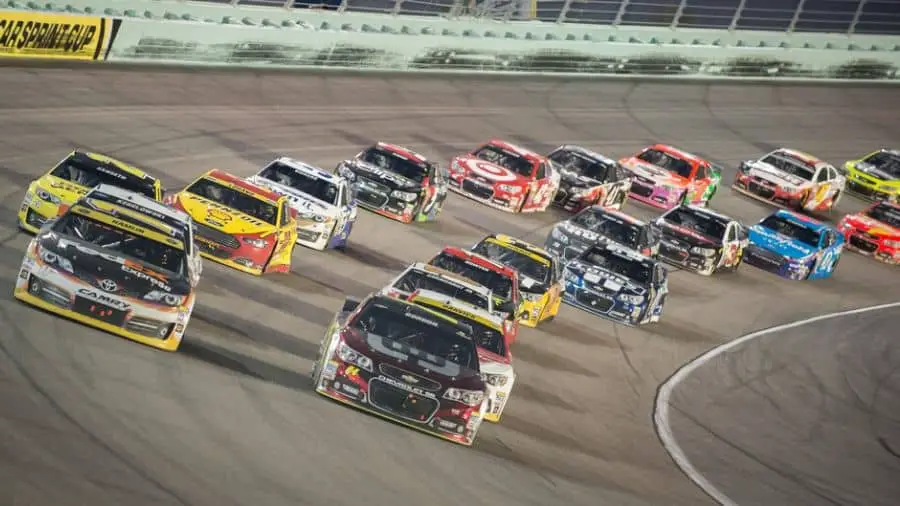
We’ve all seen it in every race we’ve watched… while there’s a caution flag, the drivers are behind the safety car, weaving back and forth. Are they just trying to show us they can turn right? Are they bored?
NASCAR drivers swerve during a caution to remove debris from their tires. During a race, “marbles” are created on the track. Swerving back and forth during the caution lap while their tires are hot keeps their tires clean of marbles during the pause in racing. This is to ensure no burn outs when the light goes green, which could be catastrophic.
So, how are marbles created? Why are they so dangerous during a caution? Why don’t NASCAR drivers swerve on full speed laps? There’s a surprising amount of science and chemistry involved in NASCAR tires, all intended to increase traction throughout the race. A key component in driver safety is the cars zigzagging behind the safety car during a caution lap.
Table of Contents
Why Marbles Cause Drivers to ZigZag and Swerve
Marbles are pieces of debris on the track, mostly made up of pieces of tire. They collect to the outside of the track and are stopped from leaving the track by the walls.
A car that drives over marbles immediately loses traction and is at risk for spinning out, crashing, or slowing down and losing its position in the race. During a caution lap, the tires are still moving on the pavement, but at a slower speed. Cars only go 60-70 mph during a caution, versus the 200 mph race speed. The slower speeds cause the tires to cool off, making them sticky.
When a slow car drives over a marble with sticky tires, the debris is picked up on the tire like duct tape on gravel.
By swerving and zigzagging behind the caution car, the drivers release the marbles from the tires, making sure that the car doesn’t spin out when the light goes green. This is like rubbing stuck gum off the bottom of your boot on a stair. It’s the same principle. They are simply rubbing these pieces of extra rubber off of their tires before they throttle down and let it rip.
Why Swerving is Important for Tires
Unlike your all-season tires or winter tires, NASCAR tires are not made to break contact with the asphalt. Any break in contact can cause the tire to slip.
During a race, a tire heats up which causes a chemical reaction in the elastomers that form the tire. This heat and chemical reaction makes for a loss of traction in the tires during the race.
Only a tiny break in contact with the asphalt can have disastrous consequences. To avoid a spin-out or a crash, the tires need to have as much contact with the asphalt as possible.
Even debris the size of a marble can cause chaos in a NASCAR race. By zigzagging and wiping off the tires before a green light, the drivers are ensuring the best possible race and setting themselves up for victory. If at any time they lose traction, they could possibly lose their life.
So no, they aren’t just showing you that they can turn right. Nor are they putting on a show for the fans. There’s legitimate and life-saving science behind zigzagging.
Why Marbles Cause the NASCAR Driver to Avoid the Outside Lane
The outside lane is longer than the inside lane, and driving a longer distance is never contusive to winning a race. The other reason why the outside lane is the worst part of the track is marbles.
When a marble is formed on a tire, it’s kicked off to the side. This isn’t a problem when it’s shot to the inside, because there’s no wall on the inside and the marbles can roll harmlessly away. For the marbles kicked to the outside of the track, however, there’s nowhere for them to go.
They get caught by the outside wall and stay on the track. After 40 cars and 200 laps… it makes for a bumpy ride. The outside lane can cause spin-outs and crashes, or it can cause the driver to pick up marbles on the tires. That’s why you’ll see drivers pull off the gas after being forced into the outside lane for a couple of laps. They’re cleaning their tires of marbles so they can really push the racing again.
All NASCAR Tracks make Different Marbles
Because the debris is from the tires itself, the track makes a difference for the amount of marbles formed on the track. Asphalt that is older and more warn has more aggregate sticking out of the top (rougher, more rocks on the surface of the asphalt). These rocks are what scrapes the hot rubber off of the tire. Tracks like Tennessee’s Bristol Motor Speedway and Darlington Raceway in South Carolina are oval shaped and have the barriers on the outside. The abrasiveness of the asphalt itself makes for a higher production of marbles. That makes staying in the groove (the inside lane) more important in these races than in other races.
Why is NASCAR Debris Called Marbles?
This one is an easy answer. The debris that’s made on tracks by the wear of the tires is called marbles because drivers say that driving over them is like driving over marbles. That’s it.
The word has stuck, even though no one knows when it was first coined. It’s called a marble, simple as that. So, if you’re new to NASCAR and you hear the commentators talking about marbles, no the fans are not throwing children’s toys onto the pavement. Nor are they placed there to make the lives of the drivers harder or to make the sport more entertaining. They look and feel like marbles made of rubber, and driving over them is like driving over marbles.
Does Weather make a Difference in NASCAR Marbles?
Water on the track affects the race beyond marble production. Even a thin layer of water can be deadly as the tires are specialized to work on dry asphalt.
The tires are bald and unlike any tire available on the market. They are also made to only have traction when a certain high temperature is reached. Any rain during a NASCAR race will cause it to be paused.
One, because it would be like any of us driving in the rain with the baldest tires available. And two, because they are made to maintain traction at a certain temperature, water on the track will decrease the temperature of the track and the tires.
Before the drivers and cars are allowed back to race, the track is dried using an Air Titan. This ensures the safety of the drivers. So, even though rain could potentially lessen the amount of marbles that are made, this hasn’t been researched as driving in the rain on those tires in the rain could be life-threatening.
